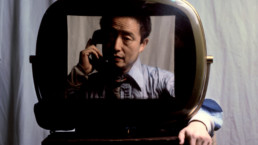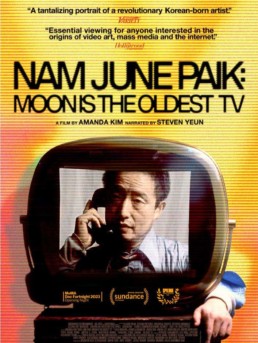Nam June Paik: Moon is the Oldest TV
A dazzling portrait of Nam June Paik, an enigmatic figure often referred to as 'The George Washington of Video Art'.
Who was Nam June Paik, the inventor of video art? Director Amanda Kim turns this question about the enigmatic figure into a dazzling portrait of reverberating inspiration in the documentary Nam June Paik: Moon is the Oldest TV. Kim, a former creative director at Vice Media, offers a generous look into the fascinating life of this true thinker. One that bustles with sound, color, and electrifying discovery.
No words will be enough to describe the legendary impact this avant-garde Korean artist had on the video art community, but many have boiled it down to one word: Eccentric. Paik’s unusual, bewildering performances left audiences in awe, and his relationship with how we embrace and utilize technology is still revered to this day as revolutionary. He had the uncanny ability to chart where technology was headed and his art reflected the potential damages, as well as possibilities, that would bring.
The film follows a traditionally linear path from Paik’s childhood in South Korea, to his studies in Germany–where he received a Ph.D. in pre-Renissance Music and Philosophy–to his professional career as an artist in New York City. Paik’s personal writings are read aloud throughout the film by Steven Yeun (Minari, Nope). The documentary does a thorough job of incorporating archival footage, as well as past and current interviews with his contemporaries (including composer John Cage and members of the Fluxus movement).
Nam June Paik has been called “The George Washington of Video Art,” the “Citizen Zero of the Electronic Superhighway,” and a “Cultural Terrorist.” But those who knew him best describe him as a humble, reserved man who spoke 20 languages and was always fiddling with something. His art took priority in his life, up until the very end. In 2006, Paik passed away at the age of 74 due to complications from an earlier stroke. “It’s the artist’s job to think about the future,” Paik so eloquently states at one point in the film. Not surprisingly, Paik’s impact on the future goes beyond his physical work. He has even been credited as having come up with the phrase “electronic superhighway” (which later was ascribed to the Internet).
Of all of Nam June Paik’s accomplishments, it’s his expression of spirituality interconnected with technology that is the most profound (aka the “why” behind his installations and performances). His way of thinking has inspired countless artists, some of whom we see in the film. Paik continues to inspire future generations through his notable works, many of which are still on display through traveling exhibitions including his 1974 video sculpture “TV Buddha.” Paik is credited with opening the door to the technological revolution, and it is our duty to make sure that door stays open.
Morgan Rojas
Certified fresh. For disclosure purposes, Morgan currently runs PR at PRETTYBIRD and Ventureland.


